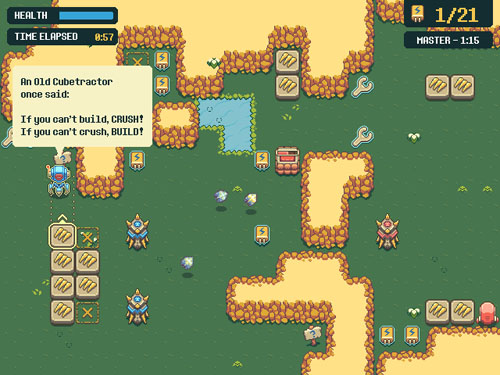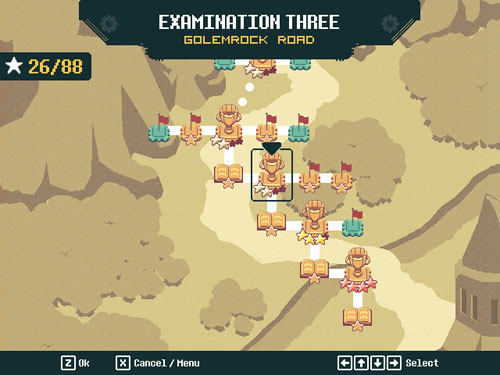A game by Ludochip for PC and Mac, originally released in 2013.
Cubetractor is a game with somewhat odd mechanics. It’s partly a resource management strategy game, partly a single screen actioner, and partly a block-pushing puzzler… or rather a block pulling puzzler.You play the part of a quadrupedal robot named Endroi, who is attempting to master the art of Cubetracting, which allows him to pull cubes toward himself from any distance. This core mechanic allows Endroi to defend himself from attackers, crush enemies, and construct turrets and other tools to fight his enemies.
Endroi has no offensive or defensive capabilities of his own and can only move about the single screen environments pulling blocks. The basic progression structure is one of tutorials and examinations, where Endroi is taught a new skill and then asked to put that skill to the test.
There are over 40 levels in the game, with a single path running up the middle of the world map representing new skills, and branching paths to the left and right where the player can execute those skills. Completing any level opens the level(s) adjacent to it, allowing players to pass on tougher levels, skip around a bit, and return to previously completed levels to go for a better rank.
Things start out very simply, and the core mechanics are built upon in a logical progression throughout the game. In the first level, there are only blocks that must be pulled. Here, you learn that blocks can be pulled in 4 directions from anywhere in the environment, except from the far side of stone walls, and they can’t be stopped or further manipulated while they are in motion. Also, you can pull multiple blocks at a time, even if they are behind one another, and blocks pulled into the water will sink and disappear, only to respawn a few seconds later in their original positions.
Next, you learn to pull blocks into enemies to destroy them, while dodging the blocks yourself, since they will cause damage if they hit you. Pulling blocks and then dodging them becomes more important later in the game as you enter more confined environments. You can also pull blocks into enemy barriers and turrets damage them, but these objects regenerate slowly over time (as do yours, once you get them), meaning that you’ll need to cause steady damage to completely destroy them. Again, this is a mechanic that becomes important later as you attempt to take down enemy defenses.
The final major mechanic is construction. By pulling two cubes together, they will combine to form one of several objects. At first, you only have the ability to create basic turrets. As in other resource management and tower defense titles, a placed turret takes a few seconds to come online and then begins auto-firing against nearby targets.
What makes Cubetractor truly interesting is that the enemy has the exact same tools at its disposal as you do (except that you do not have access to patrolling creatures). The difference is that all of the enemy’s weapons are placed at the start of the level, and they cannot build any additional units. This allows you to develop a strategy and experiment with various solutions.
There are a few varieties of turret, including the starting medium-speed bullet chucker, a rapid fire tower that has a short range, and the slow-firing homing turret that can hit targets at long distances and behind barriers. The various turrets prioritize targets differently, offering a goodly amount of additional strategy. For instance, some turrets focus on enemy turrets before moving onto other targets, while some focus on moving enemies. The homing turret focuses on power plants first, although it is easily distracted by decoys…
At your disposal are three support items: a barrier, a power plant, and a decoy. Again, the enemy has this same set of tools, so it’s important to know how each functions. The barrier simply absorbs enemy fire, while allowing your own projectiles to pass through it. Whenever possible, you will want to position a barrier in front of you turrets, as leaving them exposed may result in them being destroyed before getting off a single shot.
Another helpful tool is the power plant, which doubles the firing rate of nearby turrets and aids in taking down enemy forces quickly. Power plants have a sizeable range, extending 3 squares in each direction, allowing you to impact multiple turrets simultaneously. Generally, you will want to place power plants in a defended position. A useful configuration is placing a barrier with a turret behind it and a power plant behind that. This keeps enemy fire concentrated on your barriers while allowing for maximum firepower.
Lastly, there is the decoy which forces homing turrets to fire on it before moving on to other targets, and the decoy can take a ton of homing missile hits before it is destroyed, although this is balanced by the fact that decoys are weak against other attacks. Decoys are useful when you’re attempting to construct power plants, as homing turrets otherwise tend to focus on these. Homing turrets also give a higher priority to moving targets, so you can use yourself as a distraction to lure away enemy fire and protect your power plants.
Cubes come in several varieties and each combination yields a different type of turret or support item. Cubes regenerate over time and they reappear a few seconds after they are destroyed, or after the object built with them is destroyed. You can also manually destroy your own constructions to respawn the cubes, which is helpful in instances where a turret has destroyed its main target but cannot reach the next.
Combining cubes is fairly easy in the early going, with useful cube combinations sitting across from one another just waiting to be lined up. But eventually you will need to pull and dodge, and then chase after the cube to pull another one toward it. Later levels often require specific placement of your turrets and support items to be effective, requiring that you get the timing just right. You’ll also encounter many levels in the latter half of the game which require pulling cubes together perpendicularly, making things even more difficult. You’ll find many situations here where it’s less clear what you need to do, since the nearby cubes will allow for any number of combinations, so you’ll have to take everything you know about construction and placement and put it to good use.
You need to be careful not to pull cubes into your existing constructions, lest you destroy them. And no matter how hard things get, you must always remember the basic tactics learned in the opening levels; namely, pulled blocks can be used to attack enemies directly, and moving blocks can also block enemy projectiles. For a game with such a simple set of core mechanics, there is a surprising amount of depth to be found and a wide range of strategic possibilities.
As mentioned, you also need to avoid pulling cubes into yourself, which will knock down your life bar and leave you stunned for a moment. You can collect wrenches in the environment to restore a bit of health, but you’ll have to restart the level from scratch if you are destroyed, and taking damage also impacts your rank.
There is a sliding scale for the rank earned at the end of each level, which will reward you with up to four stars for your efforts. Merely completing the level earns you a single star. If you manage to collect all of the batteries in the level (some of which are dropped by enemies, and some are found loose), you get the silver rank and earn a second star. Finishing the level ahead of the par time will get you the gold rank and earn you a third star, as long as you also collected all of the batteries. And completing the level with all batteries, while taking no damage, and earning a very fast completion time will net you the master rank and 4 stars.
The HUD shows your health, elapsed time, the number of batteries collected versus the total, and the master completion time. If you overshoot the master time, the timer will switch to show what you need to achieve a gold rank. The world map also shows the total number of stars available in all of the levels, as well as the number earned in each individual level.
While it is possible for players of reasonable skill to work their way through the game, players looking for an additional challenge can go back and try for the top rank in each examination level, and attempt to complete all of the unranked missions that branch off of the main path. These unranked missions are entirely optional as far as completing the game is concerned, but they tend to be more difficult than the examination missions and require deft use of your skills. Killing every enemy and collecting every battery in these levels will earn you a single star, regardless of your other stats.
Cubetractor has a story that neither adds to nor detracts from the overall experience. You won't learn anything important about the game world or its puzzles by reading the dialogue, nor are there any particularly interesting character developments along the way. Outside of direct tutorial messages, most of which are delivered via signposts, there is nothing to be lost by skipping through the cutscenes altogether.
2D CRED
Cubetractor was developed by a 2-man Singapore-based studio called Ludochip, with design and art by Jianyang Tan, and programming and audio by Bruce Chia. Bruce formerly worked on CarneyVale: Showtime, winner of Microsoft’s Dream Build Play competition in 2008, while Jianyang worked on Symon, an experimental browser-based point-and-click adventure set in the mind of a paralyzed patient. Cubetractor was the first game released under the Ludochip label, and the game also received the Best Game Award in IGF China 2012.
























0 comments:
Post a Comment